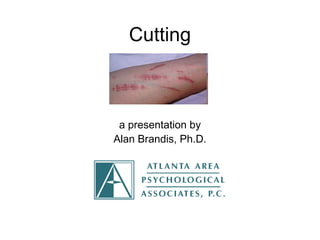
Cutting
- 1. Cutting a presentation by Alan Brandis, Ph.D.
- 2. Suicidal Thoughts Are Common in Teens From Better Off Dead, 1985, starring John Cusack
- 3. Teen Angst is Common (and can be profitable) Band: Suicidal Tendencies, 1983
- 4. Deliberate Self-Harm (DSH) is the strongest risk factor for future suicide. • English study, 2000: 11,583 patients who presented to hospital after DSH between 1978 and 1997 • The risk of suicide in the first year of follow-up was 0.7%, which was 66 times the annual risk of suicide in the general population. • The risk after 5 years was 1.7%, at 10 years 2.4%, and at 15 years 3.0%.
- 5. Co-Morbidity of DSH • Self-harm is listed in the DSM-IV-TR as a symptom of borderline personality disorder. • However, patients with other diagnoses may also self- harm, including those with depression, anxiety disorders, substance abuse, eating disorders, post-traumatic stress disorder, schizophrenia, and several personality disorders • Evaluation, diagnosis and treatment is essential to prevent progression and escalation
- 6. Motivations for Self-Harm May be used to fulfill a number of different functions. Used as a coping mechanism which provides temporary relief of intense feelings: • Emotional pain • Dissociation from body • Anxiety • Depression • Stress • Emotional numbness • Sense of failure or self-loathing • Wish to feel connection to other cutters
- 7. Origins of Self-Harm Behaviors • Often associated with a history of trauma and abuse, including emotional and sexual abuse • Most common in adolescence and young adulthood, usually first appearing between the ages of 12 and 24. • Self-harm in childhood is relatively rare but the rate has been increasing since the 1980s. • Information initially shared by peers, or learned about through music or media • Many teens have little or no perspective, everything is “life or death” to them • Often, teens cannot engage in objective problem-solving
- 10. Cutting is not the only method of Self-Harm used
- 11. Physiological Markers For Cutting, Other Self- Harming Behaviors By Teenage Girls Found University of Washington psychologists found: • Adolescent girls who engage in behaviors such as cutting themselves have lower levels of serotonin, a hormone and brain chemical, in their blood • They also have reduced levels in the parasympathetic nervous system of what is called respiratory sinus arrhythmia - a measure of the ebb and flow of heart rate along with breathing - characteristic of people who are anxious and depressed, and among boys who are delinquent
- 12. DSH Does Not Hurt (Much) • Interestingly, self-injurers report little or no pain during Self-Harm Events. • They show a higher level of pain analgesia on lab-based tests of pain tolerance. • This finding has been reported consistently across studies of DSH and represents one of the most intriguing directions for future research on this topic
- 13. Famous Self-Injurers Princess Diana Angelina Jolie Johnny Depp Courtney Love Marilyn Manson Amy Winehouse
- 14. Humor
- 15. How to tell if a student may be self-mutilating • Long sleeves in warm weather, wrist bands • Resistance to attend or dress in P.E. • Emotionally numb • Signs of repressed anger, irritability • Withdrawal from activities • Unusual interest in things that cut – knives, razor blades, etc. • May be reported to you by their friend
- 16. How NOT to Respond to Self-Harm • Don’t react in horror or upset. ("Oh, my God! How can you do that to yourself?" or "Doesn't that hurt?") • Don't be directive or judgmental. ("You must stop that." Or, “How could you do that to yourself?") Reassure them that there is nothing to be ashamed of. • Don’t say, or imply, that some sort of punishment or negative consequence will be imposed. • Don’t agree to keep it a secret. They need to get help, and you must make sure that they get it. • Don’t become a detective or inquisitor. Let them tell about their situation as they feel comfortable doing so.
- 17. Best Ways to Respond • Encourage connectedness without invading their space. ("I can see that you are hurting and I’d like to help." Or, "I may not be the right person to talk to, but I can help you find someone who is.") • Acknowledge their feelings. Offer to listen. ("You must be feeling really upset about something. I'd like to help.") • Identify the behavior as a coping mechanism, not just a bizarre habit, and preferable to the alternative of suicide. ("I guess hurting yourself seems like the best way you have right now to deal with your feelings.") • Empathize, but don’t pretend to "know" how they feel. (“When I have a problem, I feel better when I talk to someone about it.") • Emphasize hope. ("It is probably hard to imagine giving up this way of dealing with your feelings, but lots of people learn healthier ways to cope. I am sure we can find someone to help.")
- 18. Dealing With the Student’s Family • May be in denial • May overreact • Help parents understand context • Assist with referral(s)
- 19. Atlanta Area Psychological Associates (770) 953-6401 atlantapsych.com We provide Free Assessments for Fulton County Students and Fulton County School District Employees